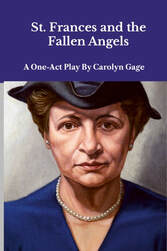St. Frances and the Fallen Angels
paperback
eBook (PDF)
eBook (EPUB)
Kindle

- 2024 Cauldron & Labrys Productions, (reading) sponsored by Bass Harbor Public Library.
- 2023 Cauldron & Labrys Productions, (reading) sponsored by Southwest Harbor Public Library, ME
This is a play about Frances Perkins, the Secretary of Labor under FDR, and her superhuman achievement of the Social Security Act of 1935. It is a story about two women in love, about the ghosts of the Triangle Shirtwaist Fire, and a true Christmas miracle. This is a play about social justice work: the price and the promise.
This is a play about the forces of greed and capitalism versus the resilience of organized labor. It is a play about the richest woman in America partnering the woman who represented the working class of the entire nation. It is a play about achieving the impossible, about rising from the ashes—literally, about the power of our remembered history, and about the genius that emerges when the ethos of individualism surrenders to the brilliance of the collective.
St. Frances and the Fallen Angels joins a panoply of seasonal holiday plays that combine social justice issues with the supernatural: It’s a Wonderful Life, A Christmas Carol, and Amahl and the Night Visitors.
It’s a Friday night—December 21, 1934—and three ghosts visit Frances Perkins during her weekend retreat at an Anglican convent. It is the end of Franklin D. Roosevelt’s second year as President and the end of Frances’ second year as his Secretary of Labor. FDR, after throwing a number of obstacles in her path, has intentionally given her a seemingly impossible deadline: Three days to complete all of the work on the proposed “old age insurance” (aka “Social Security”) bill. The ultimatum is that the work must be on his desk by Christmas Eve, if she wants him to present it to Congress in the new year. Meanwhile, Frances’ life partner, the railroad heiress Mary Rumsey, has just died earlier in the week, and Frances is alone and overwhelmed by a grief the rest of the world will never acknowledge. All of this has taken a toll, and Frances has made a decision to abandon the bill and resign her Cabinet post.
The play opens when two ghosts, victims from the Triangle Shirtwaist Fire of 1911, climb through the window. (They have been haunting Frances, who witnessed the disaster, for 23 years.) They argue over the ethics of haunting her on this night. A third apparition arrives: the ghost of Mary Rumsey, who has her own unfinished business with Frances. One of the ghosts, a union leader, has strong emotions about Mary Rumsey, the richest woman in America, and a fierce struggle ensues. A surprise revelation opens a path for both personal and political reconciliation, and the resulting alliance is why we have Social Security today.
4 women
40 minutes
Single set
